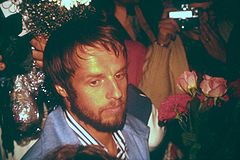Let Virén
|
Let Virén |
||||||||||||||||||||||
| Full name | Leave Artturi Virén | |||||||||||||||||||||
| nation |
|
|||||||||||||||||||||
| birthday | July 22, 1949 | |||||||||||||||||||||
| place of birth | Myrskylä | |||||||||||||||||||||
| size | 180 cm | |||||||||||||||||||||
| Weight | 60 kg | |||||||||||||||||||||
| Career | ||||||||||||||||||||||
|---|---|---|---|---|---|---|---|---|---|---|---|---|---|---|---|---|---|---|---|---|---|---|
| discipline | Long distance running | |||||||||||||||||||||
| Best performance | 13: 16.4 min ( 5000 m ) 27: 38.35 min ( 10,000 m ) 2:13:11 h ( marathon ) |
|||||||||||||||||||||
| society | Myrskylan Myrsky | |||||||||||||||||||||
| status | unknown | |||||||||||||||||||||
| Medal table | ||||||||||||||||||||||
|
||||||||||||||||||||||
|
||||||||||||||||||||||
Lasse Artturi Virén (born July 22, 1949 in Myrskylä ) is a former Finnish athlete . He specialized in long-distance running and is a four-time Olympic champion.
Career
Virén was the preeminent long distance runner of the 1970s. At the Olympic Games in Munich in 1972 and in Montréal in 1976 , he managed the so-called double and won gold medals over 5000 and 10,000 meters, respectively. His dominance in international competitions in the 1970s is comparable to the achievements of Haile Gebrselassie in the late 1990s and at the beginning of the new millennium. Virén continued the tradition of the “ flying Finns ”, founded by runners like Hannes Kolehmainen , Paavo Nurmi and Ville Ritola .
Virén was a police officer in his hometown Myrskylä and was first known to a wide public at the European Championships in Helsinki in 1971 . At that time, however, he was still in the shadow of his compatriot Juha Väätäinen , who won the 5000 and 10,000 meter runs, while Virén took seventh place over 5000 meters and 17th place over 10,000 meters. At the 1972 Olympic Games in Munich, he was the fourth runner to win both 5000 and 10,000 meters. Before him, only Paavo Nurmi, Emil Zátopek and Wolodymyr Kuz had achieved this . His victory over 10,000 meters, when he won with a world record time despite a fall, is legendary. At the European Championships in Rome in 1974 , he won the bronze medal over 5000 meters and finished seventh over 10,000 meters.
At the 1976 Olympics in Montréal, he repeated his success and won over both long distances. His victories were not without controversy: on the lap of honor after the 10,000 meter race, Virén carried his shoes in his hand. The IOC accused him of malicious intent and said the logo was visible to everyone ( sponsorship was still prohibited at the time). Virén replied that he had a blister on his foot.
In addition, he was accused of having increased his performance with blood doping, which was still permitted at the time . Blood is frozen and later fed back into the body in order to increase the ability to bind oxygen. Virén himself has always denied having used such practices.
At the 1980 Olympic Games in Moscow , Virén was fifth over 10,000 meters after narrowly qualifying for the final. He then decided not to start the 5000 meter run and instead started the marathon. During the race he was in the top group for a long time, but had to give up the race in the second half of the race due to stomach pain. In the fall of 1980 he ended his career. Virén is a well-known figure in Finland and was a member of the conservative National Collection Party in the Finnish Parliament from 1999 to 2007 and from 2010 to 2011 .
Lasse Viren in 1972 and 1976 to Finland's Sportsman of the Year and 1972 European Athlete of the Year chosen. Two life-size monuments were erected in his honor near the Helsinki Olympic Stadium and in his hometown of Myrskylä. In 2014 he was inducted into the IAAF Hall of Fame .
background
Virén preferred training in the forest. He swore by the benefits of this training. After his one-two victory at the 1972 Olympic Games , he declared: “ The tranquility of nature is a factor that contributes to strengthening mental strength; when you run in the forest you have to constantly change your pace and rhythm to avoid roots, for example, and that requires constant vigilance, as in competition. “His training was based on the principles of Arthur Lydiard , whose influence has long been visible through his work as Finland's national coach. This enabled many Finnish runners to be in top form at just the right time.
Web links
- Lasse Virén in the database of Sports-Reference (English; archived from the original )
- More about Lasse Viren IOC (Engl.)
- MP Lasse Virén eduskunta.fi ( Memento of August 22, 2009 in the Internet Archive )
Individual evidence
- ↑ EAA (Ed.): Statistics Manual, published for the European Championships 2002 in Munich, page 81
- ↑ EAA (Ed.): Statistics Manual, published for the European Championships 2002 in Munich, page 91
- ^ The other runner , photo of the Lasse Viréns monument in Helsinki on flickr.com. Retrieved April 24, 2012.
- ↑ Lasse Virén - Myrskylä , photo of the Lasse Viréns monument in Myrskylä on waymarking.com. Retrieved April 24, 2012.
- ↑ Arnd Krüger : Many roads lead to Olympia. The changes in training systems for medium and long distance runners (1850–1997). In: N. Gissel (Hrsg.): Sporting performance in change. Czwalina, Hamburg 1998, pp. 41-56.
| personal data | |
|---|---|
| SURNAME | Virén, Lasse |
| ALTERNATIVE NAMES | Virén, Lasse Artturi (full name) |
| BRIEF DESCRIPTION | Finnish athlete and politician, member of the Reichstag |
| DATE OF BIRTH | July 22, 1949 |
| PLACE OF BIRTH | Myrskylä |
